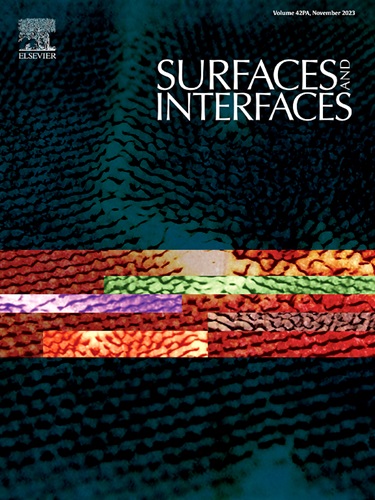Flexible alternating current electroluminescent devices using superstable AgNWs@Nd2O3/PU transparent conductive film as an electrode
IF 5.7
2区 材料科学
Q2 CHEMISTRY, PHYSICAL
引用次数: 0
Abstract
Silver nanowire transparent conductive film (AgNWs-TCF) has significant value in replacing indium tin oxide transparent conductive films in flexible electronic devices due to their excellent conductivity, transmission, and flexibility properties. However, the current issues of its environmental stability, bending resistance, and waterproof performance restrict commercialization application. In this study, a SnO2/AgNWs@Nd2O3-TCF with a core (AgNWs)-shell (Nd2O3) structure was fabricated through a two-step process: First, silver obtained from reduction in NaCl solution was used to softly weld wire-to-wire junctions in the AgNWs network, followed by Nd2O3 derived from hydrolysis in NdF3 solution to encapsulate the AgNWs. The resulting transparent conductive film not only demonstrated excellent optoelectronic performance with a sheet resistance of 11.6 Ω/sq and transmittance of 86.6 %@550 nm, but also exhibited remarkable environmental stability and bending resistance, showing resistance change rates of 24 % after 28 days in ambient air and 4.8 % at a bending radius of 5.5 mm, respectively. After polyurethane resin (PU) encapsulation, the SnO2/AgNWs@Nd2O3/PU-TCF displayed superior waterproof characteristics, maintaining a current of 0.10 A under 4 V voltage even after coating a water layer. Surface roughness analysis revealed that TCFs significantly influence the luminescence properties of AC electroluminescent devices (ACEL). The ACEL device fabricated with low-roughness SnO2/AgNWs@Nd2O3-TCF/PU as a flexible transparent electrode achieved a luminous brightness of 43.11 cd/m2 and demonstrated stable bending luminescence performance with negligible changes in brightness uniformity.

求助全文
约1分钟内获得全文
求助全文
来源期刊

Surfaces and Interfaces
Chemistry-General Chemistry
CiteScore
8.50
自引率
6.50%
发文量
753
审稿时长
35 days
期刊介绍:
The aim of the journal is to provide a respectful outlet for ''sound science'' papers in all research areas on surfaces and interfaces. We define sound science papers as papers that describe new and well-executed research, but that do not necessarily provide brand new insights or are merely a description of research results.
Surfaces and Interfaces publishes research papers in all fields of surface science which may not always find the right home on first submission to our Elsevier sister journals (Applied Surface, Surface and Coatings Technology, Thin Solid Films)
 求助内容:
求助内容: 应助结果提醒方式:
应助结果提醒方式:


